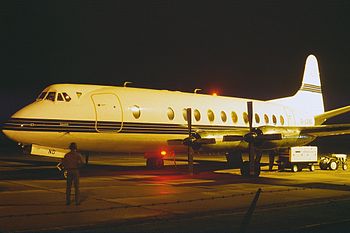South African Airways Flight 406

A Viscount 806, similar to the accident aircraft
|
|
| Accident summary | |
|---|---|
| Date | 13 March 1967 |
| Summary | Loss of control, Pilot incapacitation |
| Site | Indian Ocean off Kayser's Beach, Cape Province, South Africa 33°13.45′S 27°38.3′E / 33.22417°S 27.6383°ECoordinates: 33°13.45′S 27°38.3′E / 33.22417°S 27.6383°E |
| Passengers | 20 |
| Crew | 5 |
| Fatalities | 25 |
| Survivors | 0 |
| Aircraft type | Vickers Viscount 818 |
| Aircraft name | Rietbok |
| Operator | South African Airways |
| Registration | ZS-CVA |
| Flight origin | H.F. Verwoerd Airport, Port Elizabeth |
| 1st stopover | Ben Schoeman Airport, East London |
| 2nd stopover | J.B.M. Hertzog Airport, Bloemfontein |
| Destination | Jan Smuts Int'l Airport, Johannesburg |
South African Airways Flight 406, also known as the Rietbok Crash, was a scheduled passenger flight on 13 March 1967 that crashed into the sea on approach to East London, South Africa. All 25 passengers and crew on board were killed. The air accident report speculated, without supporting evidence, that the pilot of the plane suffered a heart attack while on approach and the co-pilot was unable to regain control of the aircraft. Like the crash of South African Airways Flight 295 two decades later, there was, and still is great contention about the ultimate cause of the aircraft accident.
Captain Lipawsky's day started with a flight departing from Johannesburg in the afternoon on a flight to Port Elizabeth with stopovers in Bloemfontein and East London.After take-off from Jan Smuts Airport (now O. R. Tambo International Airport), the front nosewheel would not retract due to mechanical malfunction.The aircraft returned to the airport and repaired, and the same plane was used to continue the flight. At 3:50 pm GMT, the plane landed in East London in poor weather. On departure from East London, the plane suffered a bird strike and was inspected upon landing at Port Elizabeth where it was determined to still be airworthy.
From Port Elizabeth to Johannesburg, the plane was marketed as Flight 406. Knowing he may need to bypass a landing in East London due to poor weather, Captain Lipawsky took on more fuel than would usually be loaded for the flight between Port Elizabeth and East London. He also told the passengers scheduled to disembark at East London aware that they may need to overfly the airport. One passenger stayed in Port Elizabeth to wait for a better chance to land, while the other passenger decided to continue with the flight, and stay overnight in Johannesburg if needed. At 4:41 pm GMT, Flight 406 took off from Port Elizabeth, and a 4:58 GMT, a weather report for East London was given. Acknowledgement of receipt of the weather report was given a minute later, and the pilot further requested descent clearance from flight level 90 (about 9,000 feet), which was granted. Air traffic control at East London requested the pilot to radio when he passed 4,500 ft. The pilot was recorded at Port Elizabeth tower saying that he was descending through 4,000 ft, seaward of the coastline and about 20 miles away from landing at 5:06 pm GMT. The pilot was made aware that lights for both runways were on, but runway 10 was not available due to poor visibility. At 5:09 pm GMT (estimated), the pilot radioed to say he was at 2,000 ft and had the coast in sight. After this transmission, the plane was not heard from again.
...
Wikipedia
